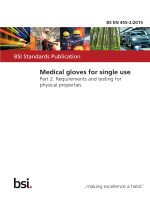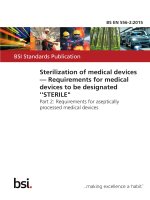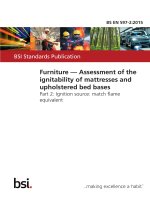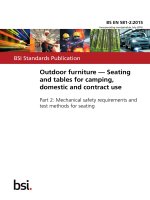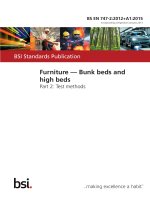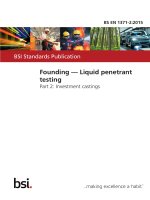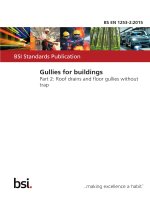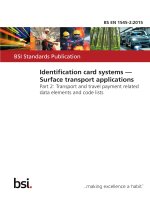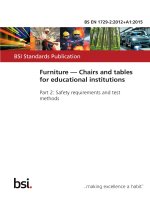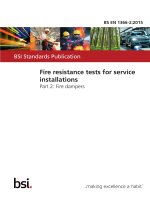Bsi bs en 50636 2 107 2015
Bạn đang xem bản rút gọn của tài liệu. Xem và tải ngay bản đầy đủ của tài liệu tại đây (2.54 MB, 76 trang )
BS EN 50636-2-107:2015
BSI Standards Publication
Safety of household and
similar appliances
Part 2-107: Particular requirements
for robotic battery powered electrical
lawnmowers
BRITISH STANDARD
BS EN 50636-2-107:2015
National foreword
This British Standard is the UK implementation of EN 50636-2-107:2015.
It is derived from IEC 60335-2-107:2012.
BSI, as a member of CENELEC, is obliged to publish EN 50636-2-107:2015
as a British Standard. However, attention is drawn to the fact that the UK
committee voted against its approval as a European Standard.
The UK committee has concerns that the 60° angle at which the lift sensor
operates (see 22.105.3) is excessive.
The UK participation in its preparation was entrusted to Technical
Committee CPL/116, Safety of motor-operated electric tools.
A list of organizations represented on this committee can be obtained on
request to its secretary.
This publication does not purport to include all the necessary provisions of
a contract. Users are responsible for its correct application.
© The British Standards Institution 2015.
Published by BSI Standards Limited 2015
ISBN 978 0 580 83161 4
ICS 65.060.70
Compliance with a British Standard cannot confer immunity from
legal obligations.
This British Standard was published under the authority of the
Standards Policy and Strategy Committee on 30 April 2015.
Amendments/corrigenda issued since publication
Date
Text affected
BS EN 50636-2-107:2015
EUROPEAN STANDARD
EN 50636-2-107
NORME EUROPÉENNE
EUROPÄISCHE NORM
January 2015
ICS 65.060.70
English Version
Safety of household and similar appliances - Part 2-107:
Particular requirements for robotic battery powered electrical
lawnmowers
(IEC 60335-2-107:2012 , modified)
This European Standard was approved by CENELEC on 2014-12-01. CENELEC members are bound to comply with the CEN/CENELEC
Internal Regulations which stipulate the conditions for giving this European Standard the status of a national standard without any alteration.
Up-to-date lists and bibliographical references concerning such national standards may be obtained on application to the CEN-CENELEC
Management Centre or to any CENELEC member.
This European Standard exists in three official versions (English, French, German). A version in any other language made by translation
under the responsibility of a CENELEC member into its own language and notified to the CEN-CENELEC Management Centre has the
same status as the official versions.
CENELEC members are the national electrotechnical committees of Austria, Belgium, Bulgaria, Croatia, Cyprus, the Czech Republic,
Denmark, Estonia, Finland, Former Yugoslav Republic of Macedonia, France, Germany, Greece, Hungary, Iceland, Ireland, Italy, Latvia,
Lithuania, Luxembourg, Malta, the Netherlands, Norway, Poland, Portugal, Romania, Slovakia, Slovenia, Spain, Sweden, Switzerland,
Turkey and the United Kingdom.
European Committee for Electrotechnical Standardization
Comité Européen de Normalisation Electrotechnique
Europäisches Komitee für Elektrotechnische Normung
CEN-CENELEC Management Centre: Avenue Marnix 17, B-1000 Brussels
© 2015 CENELEC All rights of exploitation in any form and by any means reserved worldwide for CENELEC Members.
Ref. No. EN 50636-2-107:2015 E
BS EN 50636-2-107:2015
EN 50636-2-107:2015
-2-
Contents
Foreword...................................................................................................................................................4
Introduction ...............................................................................................................................................6
1
Scope ................................................................................................................................................7
2
Normative references ........................................................................................................................7
3
Definitions ..........................................................................................................................................9
4
General requirement ...................................................................................................................... 12
5
General conditions for the tests ..................................................................................................... 12
6
Classification .................................................................................................................................. 12
7
Marking and instructions ................................................................................................................ 12
8
Protection against access to live parts ........................................................................................... 16
9
Starting of motor-operated appliances ........................................................................................... 16
10 Power input and current ................................................................................................................. 16
11 Heating ........................................................................................................................................... 16
12 Void ................................................................................................................................................ 16
13 Leakage current and electric strength at operating temperature ................................................... 16
14 Transient overvoltages ................................................................................................................... 16
15 Moisture resistance ........................................................................................................................ 16
16 Leakage current and electric strength ............................................................................................ 17
17 Overload protection of transformers and associated circuits ......................................................... 17
18 Endurance ...................................................................................................................................... 17
19 Abnormal operation ........................................................................................................................ 17
20 Stability and mechanical hazards ................................................................................................... 18
21 Mechanical strength ....................................................................................................................... 26
22 Construction ................................................................................................................................... 29
23 Internal wiring ................................................................................................................................. 37
24 Components ................................................................................................................................... 37
25 Supply connection and external flexible cords ............................................................................... 37
26 Terminals for external conductors .................................................................................................. 37
27 Provision for earthing ..................................................................................................................... 37
28 Screws and connections ................................................................................................................ 37
29 Clearances, creepage distances and solid insulation .................................................................... 37
30 Resistance to heat and fire............................................................................................................. 37
31 Resistance to rusting ...................................................................................................................... 37
32 Radiation, toxicity and similar hazards ........................................................................................... 38
Annexes ................................................................................................................................................. 45
Annex B (normative) Appliances powered by rechargeable batteries ................................................ 45
Annex R (normative) Software evaluation ........................................................................................... 47
Annex AA (normative) Calculation of kinetic energy of pivoting cutting elements .............................. 48
Annex BB (normative) Test enclosure construction ........................................................................... 50
Annex CC (normative) Base for thrown object test enclosure ............................................................ 55
-3-
BS EN 50636-2-107:2015
EN 50636-2-107:2015
Annex DD (normative) Target panel elevation zones and recommended test report for thrown
object test ....................................................................................................................................... 57
Annex EE (normative) Safety signs ..................................................................................................... 59
Annex FF (normative) Noise test code – Engineering method (grade 2) ............................................ 62
Annex GG (informative) Example of a material and construction fulfilling the requirements for an
artificial surface .............................................................................................................................. 67
Annex HH (informative) Safety instructions......................................................................................... 69
Annex ZZ (informative) Coverage of Essential Requirements of Directive 2006/42/EC ...................... 71
Bibliography ........................................................................................................................................... 72
Figures
Figure 101 – Example of test cycles (see Clause 20.102.2) ................................................................. 38
Figure 102 – Foot probe test (see Clause 20.102.4) ............................................................................ 39
Figure 103 – Impact test fixture (see Clause 21.101.1) ........................................................................ 40
Figure 104 – Example of structural integrity test fixtures (see Clause 21.101.3.1.1)............................ 42
Figure 105 - Finger probe test - Illustrations showing application of probe, insertion depth limited
according to the geometry of the enclosure .......................................................................................... 43
Figure 106 - Obstruction sensor test - Illustration showing typical arrangement (see
Clause 22.105.2) ................................................................................................................................... 44
Figure AA.1 – Measurement of the reckonable length L ....................................................................... 49
Figure BB.1 – Thrown object test enclosure – General layout .............................................................. 51
Figure BB.2 – Thrown object test enclosure ......................................................................................... 52
Figure BB.3 – Test enclosure walls and base ....................................................................................... 53
Figure BB.4 – Test fixture for corrugated fibreboard penetration test ................................................... 54
Figure CC.1 – Thrown object test enclosure – Base detail ................................................................... 55
Figure CC.2 – Nail plan of test enclosure base ..................................................................................... 56
Figure DD.1 – Recommended test data sheet ...................................................................................... 58
Figure EE.1 – Safety sign illustrating – " WARNING – Read user instructions before operating the
machine " ............................................................................................................................................... 59
Figure EE.2 – Alternative safety sign for the supplementary safety information panel of
Figure EE.1 (safety sign 1641 of ISO 7000:2014) ................................................................................ 59
Figure EE.3 – Alternative safety sign for the supplementary safety information panel of
Figure EE.1 (safety sign M002 of EN ISO 7010:2012) ......................................................................... 59
Figure EE.4 – Safety sign illustrating – "WARNING – Keep a safe distance from the machine
when operating" ..................................................................................................................................... 60
Figure EE.5 – Safety sign illustrating – “WARNING – Remove the disabling device before working
on or lifting the machine" ....................................................................................................................... 60
Figure EE.6 – Safety sign illustrating – “WARNING – Operate the disabling device before working
on or lifting the machine" ....................................................................................................................... 61
Figure EE.7 – Safety sign illustrating – "WARNING – Do not ride on the machine" ............................. 61
Figure FF.1 – Microphone positions on the hemisphere (see Table FF.1) ........................................... 63
Figure GG.1 – Sketch of the measurement surface covered with an artificial surface (not to scale) .. 68
Tables
Table 1 – Sizing of test fixture air inlet holes ......................................................................................... 28
Table FF.1 – Co-ordinates of microphone positions ............................................................................. 64
Table FF.2 – Absorption coefficients ..................................................................................................... 64
BS EN 50636-2-107:2015
EN 50636-2-107:2015
-4-
Foreword
This document (EN 50636-2-107:2015) has been prepared by CLC/TC 116, "Safety of hand-held
motor-operated electric tools".
The following dates are fixed:
•
•
latest date by which the standard has to be implemented
at national level by publication of an identical
national standard or by endorsement
(dop)
2015-12-01
latest date by which the national standards conflicting
with the standard have to be withdrawn
(dow)
2017-12-01
Attention is drawn to the possibility that some of the elements of this document may be the subject of
patent rights. CENELEC shall not be held responsible for identifying any or all such patent rights.
This document has been prepared under a mandate given to CENELEC by the European Commission
and the European Free Trade Association, and supports essential requirements of EU Directives.
For the relationship with EU Directive 2006/42/EC, see informative Annex ZZ, which is an integral part
of this document.
The text of IEC 60335-2-107:2012 has been revised by CLC/TC 116/WG 5, "Garden appliances", to
bring this European Standard in line with the European Machinery Directive 2006/42/EC.
This document was submitted to the UAP under the reference FprEN 60335-2-107:2013. CLC/TC 116
confirmed that EN 60335-1:2012 is Part 1 of this document.
This European Standard is to be used in conjunction with EN 60335-1:2012 “Household and similar
electrical appliances - Safety – Part 1: General requirements” and its amendments.
When “Part 1” is mentioned in this standard, it refers to EN 60335-1:2012.
This European Standard supplements or modifies the corresponding clauses in Part 1, so as to
convert that publication into the European Standard “Particular requirements for robotic battery
powered electrical lawnmowers”.
Where a particular subclause of Part 1 is not mentioned in this European Standard, that subclause
applies as far as is relevant. Where this standard states “addition”, “modification” or “replacement”, the
relevant text in Part 1 is to be adapted accordingly.
Compliance with the relevant clauses of Part 1 together with this European Standard provides one
means of conforming to the specified essential health and safety requirements of the Directive
concerned.
This European Standard follows the overall requirements of EN ISO 12100:2010.
Warning:
Other requirements arising from other EU Directives can be applicable to the products
falling within the scope of this European Standard.
The following numbering system is used:
–
subclauses that are numbered starting from 101 are additional to those in Part 1;
–
additional annexes are lettered AA, BB, etc.
NOTE In this European Standard the following print types are used:
-
requirements proper: in Roman type;
-5-
-
test specifications: in italic type;
-
explanatory matter: in smaller Roman type.
BS EN 50636-2-107:2015
EN 50636-2-107:2015
Words in bold in the text are defined in Clause 3. When a definition concerns an adjective, the adjective and the associated
noun are also in bold.
BS EN 50636-2-107:2015
EN 50636-2-107:2015
-6-
Introduction
This document is a type C standard as stated in EN ISO 12100:2010.
The machinery concerned and the extent to which hazards, hazardous situations and events are covered
is as indicated in the scope of this document.
When provisions of this type C standard are different from those which are stated in type A or B
standards, the provisions of this type C standard take precedence over the other standards, for machines
which have been built and designed to the provisions of this type C standard.
-7-
1
BS EN 50636-2-107:2015
EN 50636-2-107:2015
Scope
This clause of Part 1 is replaced by the following:
This European Standard specifies safety requirements and their verification for the design and
construction of robotic battery powered electrical rotary lawnmowers and their peripherals with the
rated voltage of the battery being not more than 75 V d.c. charged by mains electrical and/or alternative
energies, e.g. solar power.
This European Standard does not apply to non-robotic machines such as lawn trimmers, lawn edge
trimmers, lawn edgers, ride-on lawnmowers or pedestrian controlled lawnmowers.
This European Standard is not applicable to EMC and environmental hazards (except noise).
This European Standard does not apply to internal combustion engine(s), hybrid and fuel cell powered
machines and associated charging systems.
This European Standard deals with all the significant hazards presented by battery powered robotic
lawnmowers and their peripherals when they are used as intended and under conditions of misuse
which are reasonably foreseeable.
This European Standard is not applicable to machines, which are manufactured before the date of
publication of this document by CENELEC.
NOTE
2
This European Standard does not apply to battery chargers (EN 60335-2-29:2004).
Normative references
This clause of Part 1 is applicable except as follows.
Addition:
EN 60320-1:2001+ EN 60320-1:2001/A1:2007, Appliance couplers for household and similar general
purposes – Part 1: General requirements (IEC 60320-1:2001 + A1:2007)
EN 60320-2-1:2000, Appliance couplers for household and similar general purposes – Part 2-1: Sewing
machine couplers (IEC 60320-2-1:2000)
EN 60320-2-2:1998, Appliance couplers for household and similar general purposes – Part 2-2:
Interconnection couplers for household and similar equipment (IEC 60320-2-2:1998)
EN 60320-2-4:2006 + EN 60320-2-4:2006/A1:2009, Appliance couplers for household and similar general
purposes – Part 2 -4: Appliance couplers dependent on appliance weight for engagement (IEC 60320-24:2005 + A1:2009)
EN 60335-1:2012, Household and similar electrical appliances – Safety – Part 1: General requirements
(IEC 60335-1:2010, mod.)
EN 60335-2-29:2004, Household and similar electrical appliances – Safety – Part 2-29: Particular
requirements for battery chargers (IEC 60335-2-29:2002)
EN 61032:1998, Protection of persons and equipment by enclosures – Probes for verification
(IEC 61032:1997)
EN 62133:2003, Secondary cells and batteries containing alkaline or other non-acid electrolytes – Safety
requirements for portable sealed secondary cells, and for batteries made from them, for use in portable
applications (IEC 62133:2002)
EN ISO 354:2003, Acoustics – Measurement of sound absorption in a reverberation room (ISO 354:2003)
BS EN 50636-2-107:2015
EN 50636-2-107:2015
-8-
EN ISO 3744:2010, Acoustics – Determination of sound power levels and sound enrgy levels of noise
sources using sound pressure – Engineering methods for an essentially free field over a reflecting plane
(ISO 3744:2010)
EN ISO 4871:2009, Acoustics – Declaration and verification of noise emission values of machinery and
equipment (ISO 4871:1996)
EN ISO 7010:2012, Graphical symbols – Safety colours and safety signs – Registered safety signs
(ISO 7010:2011)
EN ISO 11201:2010, Acoustics – Noise emitted by machinery and equipment – Determination of
emission sound pressure levels at a work station and at other specified positions in an essentially free
field over a reflecting plane with negligible environmental corrections (ISO 11201:2010)
EN ISO 11203:2009, Acoustics – Noise emitted by machinery and equipment – Determination of
emission sound pressure levels at a work station and at other specified positions from the sound power
level (ISO 11203:1995)
EN ISO 11688-1:2009, Acoustics – Recommended practice for the design of low-noise machinery and
equipment – Part 1: Planning (ISO/TR 11688-1:1995)
EN ISO 12100:2010, Safety of machinery – General principles for design – Risk assessment and risk
reduction (ISO 12100:2010)
EN ISO 13857:2008, Safety of machinery – Safety distances to prevent hazard zones being reached by
upper and lower limbs (ISO 13857:2008)
ISO 683-4:2014, Heat-treatable steels, alloy steels and free-cutting steels – Part 4: Free-cutting steels
ISO 3767-1:1998+A1:2008+A2:2012, Tractors, machinery for agriculture and forestry, powered lawn and
garden equipment – Symbols for operator controls and other displays – Part 1: Common symbols
ISO 3767-3:1995, Tractors, machinery for agriculture and forestry, powered lawn and garden equipment
– Symbols for operator controls and other displays – Part 3: Symbols for powered lawn and garden
equipment
ISO 7000:2014, Graphical symbols for use on equipment – Index and synopsis
ISO 11684:1995, Tractors, machinery for agriculture and forestry, powered lawn and garden equipment –
Safety signs and hazard pictorials – General principles
-9-
3
BS EN 50636-2-107:2015
EN 50636-2-107:2015
Definitions
This clause of Part 1 is applicable except as follows.
3.101
Void
3.102
control
means or device which will control the operation of the machine or any specific operating function thereof
3.103
cutting means
mechanism used to provide the cutting action
Note 1 to entry
The term “blade” can be used in warnings and instructions to denote “cutting means”.
3.104
cutting means enclosure
part or assembly which provides the protective means around the cutting means
3.105
cutting means tip circle
path described by the outermost point of the cutting means as it rotates about its shaft axis
3.106
cutting position
any height setting of the cutting means designated by the manufacturer for cutting grass
3.107
disabling device
a) removable
detachable part, such as for example a key, which prevents operation of the lawnmower when it is
removed
b) code protected
device which, when operated, prevents operation of the lawnmower and requires a coded input (such as
via a keypad) before it can operate
Note 1 to entry: See Clause 22.103.
3.108
discharge chute
extension of the cutting means enclosure from the discharge opening, generally used to control the
discharge of material from the cutting means
3.109
discharge opening
gap or opening in the cutting means enclosure through which grass can be discharged
3.110
charging station
automatic battery charging facility located on or within the delimited or pre-programmed area
3.111
manual stop
device using software-based or hardware-based components that overrides all other controls and
removes power to the motor(s) and brings all moving parts to a stop
3.112
grass catcher
part or combination of parts which provides a means for collecting grass clippings or debris
BS EN 50636-2-107:2015
EN 50636-2-107:2015
- 10 -
3.113
guard
part of the machine or a component incorporated to provide protection for the operator and/or bystander
by means of a physical barrier
3.114
intended use
any use of the machine which is reasonably foreseeable, as described in the instruction manual, and
which is consistent with such activities as cutting grass, starting, stopping, or connecting to (or
disconnecting from) a source of power
3.115
lawn edge trimmer
powered grass cutting machine for trimming lawn edges usually in a vertical plane
3.116
lawn edger
powered machine suitable for cutting lawn and soil, usually in a vertical plane
3.117
lawnmower
grass-cutting machine where the cutting means operates in a plane approximately parallel to the ground
and which uses the ground to determine the height of cut by means of wheels, air cushion or skids, etc.,
and which utilizes an electric motor for a power source
3.118
lawn trimmer
powered grass-cutting machine where the operator determines the plane of operation of the cutting
means and the height of cut, possibly assisted by a wheel or skid, etc.
3.119
manual controller
device either connected by a wire or wireless that allows manual control of the movement and cutting
means operation of the machine
3.120
maximum operating motor speed
the highest motor speed obtainable when adjusted in accordance with the manufacturers specifications
and/or instructions, with the cutting means engaged
3.121
mowing attachment
cutting means designed to be easily detached from the machine, generally to allow the machine to be
used for other purposes
3.122
mulching lawnmower
rotary lawnmower without discharge openings in the cutting means enclosure
3.123
no load
the minimum load attainable at rated voltage
3.124
operator control
any control requiring operator actuation to perform specific functions
Note 1 to entry: This includes controls on a manual controller.
3.125
operator presence control
control on a manual controller designed so that it will automatically interrupt power to a drive when the
operator's actuating force is removed
- 11 -
BS EN 50636-2-107:2015
EN 50636-2-107:2015
3.126
pedestrian controlled lawnmower
grass-cutting machine, either pushed or self-propelled, normally controlled by the operator holding a
handle walking behind the unit
3.127
perimeter delimiter
a device(s) that define the perimeter of the area within which the machine can operate automatically
3.128
power source
motor which provides mechanical energy for linear or rotational movement
3.129
ride-on lawnmower
self-propelled lawnmower on which an operator rides and which is designed primarily for cutting grass
3.130
robotic lawnmower
unattended lawnmower that operates automatically
Note 1 to entry: When the term 'machine' is used in the text of this standard, it is used to denote a robotic lawnmower.
3.131
rotary lawnmower
lawnmower in which the cutting means, cutting by impact, rotate about an axis (axes) normal to the
cutting plane
3.132
sensor
device that responds to physical stimuli (such as, but not limited to, heat, light, sound, pressure,
magnetism, motion) and transmits the resulting signal or data providing a measurement, operating a
control, or both:
a) lift sensor
device that senses when the machine is lifted bodily from the ground
b) obstruction sensor
device that senses when the machine contacts an obstruction
c) tilt sensor
device that senses when the machine is at or above a predetermined angle of incline
d) rollover sensor
device that senses when the machine is inverted
3.133
stopping time
the time elapsed between the instant when either a sensor is activated or the actuator on a manual
controller is released and the instant at which the machine or component comes to a stop
3.134
thrown object hazard
the potential for injury caused by object(s) propelled by the moving cutting means
3.135
traction drive
the means (system) used to transmit power from the power source to the ground drives means
3.136
remote setting device
a setting device which is not connected by wire to the lawnmower and designed to set the basic
functions of the lawnmower but not for controlling the lawnmower
BS EN 50636-2-107:2015
EN 50636-2-107:2015
- 12 -
3.137
working area
any defined area in which the machine can function automatically
3.138
peripherals
equipment additional to the machine itself that is provided by the manufacturer for intended use of the
machine, e.g. charging station(s), manual controller
4
General requirement
This clause of Part 1 is applicable except as follows:
4.101 Attachments
Where attachments are available from the original manufacturer which modify the use of a robotic
lawnmower, the complete machine shall still comply with the safety requirements of this standard.
Compliance is checked by inspection and by the relevant tests, where applicable.
5
General conditions for the tests
This clause of Part 1 is applicable except as follows:
5.1
Addition:
Where an electronic speed control device can be adjusted, it is set for the highest speed.
5.2 Replacement:
A new machine shall be used for each of the tests of Clause 21.
5.8.1
Replacement:
Unless otherwise specified, a fully charged battery shall be used for each test. Where for consecutive
tests the same battery is specified, there shall be a minimum of 1 min rest time between tests.
6
Classification
This clause of Part 1 is applicable except as follows:
6.1 Replacement:
Machines shall be of one of the following classes with respect to protection against electric shock:
−
machines and charging stations with a rated voltage above 42 V shall be class II;
parts of machines with an integrated mains powered charger shall be class II; other parts complying
with SELV shall be at least class III;
−
charging stations supplied with SELV shall be at least class III;
−
other machines shall be at least class III.
Compliance is checked by inspection and by the relevant tests.
6.2
Addition:
Class II parts of machines shall be at least IPX4.
Class III machines shall be at least IPX1.
7
Marking and instructions
This clause of Part 1 is applicable except as follows:
- 13 -
BS EN 50636-2-107:2015
EN 50636-2-107:2015
7.1 Replacement:
Replace the third indent by:
7.1
rated power in kilowatts or rated current in amperes for mains supplied chargers
Addition:
Add the following indents:
−
business name and full address of the manufacturer and, where applicable, his authorized
representative;
−
year of construction;
−
mass in kilograms;
−
designation of the machine,
designation of machine may be achieved by a combination of letters and/or numbers provided that
this code is explained by giving the explicit designation such as “battery powered robotic
lawnmowers” etc. in the instructions supplied with the machine;
NOTE 1 An example of such code is “A123B”.
−
designation of series or type,
allowing the technical identification of the product. This may be achieved by a combination of letters
and/or numbers and may be combined with the designation of machine;
NOTE 2 The term “designation of series or type” is also known as model number.
−
serial number, if any;
−
mandatory markings;
NOTE 3 For machines and their related products intended to be put on the market in the EEA, CE-marking as defined in the
applicable European Directive(s), e.g. the Machinery Directive.
−
symbol IEC 60417-5172 for class II machines only;
−
symbol IEC 60417-5180 (2003-02), for class III machines. This marking is not necessary for
machines that are operated only by batteries (primary batteries or secondary batteries that are
recharged outside of the machine);
−
cutting width in centimetres.
Controls which may give rise to a hazard (e.g. operator presence controls in accordance with Clause
20.101.1) when operated shall be marked or so placed as to indicate clearly which part of the machine
they control.
The following warnings shall be located in easily visible positions, indicating:
On the machine:
WARNING – Read instruction manual before operating the machine.
WARNING – Keep a safe distance from the machine when operating.
WARNING – Do not ride on the machine.
WARNING – Remove (or operate) the disabling device before working on or lifting the machine.
NOTE 4 Use “Remove” or “Operate” as appropriate to the type of disabling device that is fitted to the machine.
CAUTION – Do not touch rotating blade.
BS EN 50636-2-107:2015
EN 50636-2-107:2015
- 14 -
For machines equipped with a manual controller, the manual controller shall be marked with:
WARNING – Read instruction manual before operating the machine.
WARNING – Keep a safe distance from the machine when operating.
Marking giving cautionary information shall be located as close as practicable to the relevant hazard.
Such marking shall be in one of the official languages of the country in which the machine is to be sold.
Instead of written markings, symbols according to Annex EE are allowed. Symbols according to
ISO 3767-1:1998+A1:2008+A2:2012, ISO 3767-3:2003, ISO 11684:1995 and EN ISO 7010:2012 may
also be used as appropriate. Contrasting colours shall be used unless the symbols are cast, embossed or
stamped when colours are not required. If symbols are used, their significance shall be described in the
instruction manual.
Also:
−
the cutting means shall be marked for identification;
−
if a grass catcher requires an adapter to be used, instructions shall be affixed to the machine near
the discharge opening and to the grass catcher adapter stating that the machine shall not be
operated without either the entire grass catcher or guard in place.
7.6 Addition:
Additional symbols are shown in Annex EE.
7.8 Addition:
If a cell or battery is intended to be replaced by the user and it is possible for it to be put in a reverse
polarity then the correct location and polarity shall be marked at its intended location.
7.9 Modification:
Replace the first paragraph by the following:
Operator controls shall have the function, direction and/or method of operation clearly identified by a
durable label or mark.
The manual stop shall be marked with the word "STOP" and be coloured red, no other externally visible
controls shall be coloured red.
7.12 Replacement:
An instruction manual shall be supplied with the machine, giving operating, servicing, maintenance and
safety instructions that comply as appropriate with EN ISO 12100:2010, Clause 6.4. The words ‘Original
instructions’ shall appear on the language version(s) verified by the manufacturer or his authorized
representative. Where no ‘Original instructions’ exist in the official language(s) of the country where the
machine is to be used, a translation into that/those language(s) shall be provided by the manufacturer or
his authorized representative or by the person bringing the machine into the language area in question.
The translations shall bear the words ‘Translation of the original instructions’, and they shall be
accompanied by a copy of the ‘Original instructions’.
This instruction manual shall include:
a) a repeat of those warnings required to be marked on the machine together with further explanation,
where appropriate. Where safety signs are used in the marking on the machine, their function shall be
explained;
b) a warning to never allow children, persons with reduced physical, sensory or mental capabilities or
lack of experience and knowledge or people unfamiliar with these instructions to use the machine,
local regulations may restrict the age of the operator;
c) a warning, not to allow children to be in the vicinity or play with the machine when it is operating;
d) a general description of the machine and its peripherals, the intended use, instructions for the proper
use of the machine including advice on what the machine and its peripherals should be used for, how
to use it for the intended purpose(s) and any reasonably foreseeable misuse thereof;
- 15 -
BS EN 50636-2-107:2015
EN 50636-2-107:2015
e) warnings concerning ways - that experience has shown might occur - in which the machinery shall
not be used;
f)
instructions for the proper assembly and disassembly of the machine and its peripherals for use, if the
machine and/or its peripherals are not supplied in a completely assembled form;
g) instructions for proper adjustment and any necessary user maintenance of the machine and its
peripherals, including timescales and a warning of the danger of moving hazardous parts;
h) instructions for the proper setting out the perimeter of the working area;
i)
instructions for the recommended replacement or repair of, or service attention to, critical
components. Where parts are consumable, the spare part shall be clearly identified, e.g. by the use of
a part number or other means;
j)
instructions on the operation of all controls;
k) information how to start and operate the machine safely;
l)
instructions for the operating position and the correct and safe operation of the machine and its
peripherals such as moving, safe positioning, handling, clearing blockages, and if a collecting facility
is provided keeping the discharge chute clear of processed material, for use, preparation,
maintenance and storage of the machine;
m) an advice to not overreach and to keep the balance at all times, to always be sure of the footing on
slopes and to walk, never run while operating the machine or its peripherals;
n) a warning not to touch moving hazardous parts before these have come to a complete stop;
o) details of the battery charger to be used and advice on the safe disposal of batteries at the end of
their life;
p) if designed for use with an extension cord, an advice on the use, length and type of extension cords
to be used (not lighter than required by Clause 25.7);
q) if a collecting facility is provided with the machine, instructions for when and how to attach and detach
the collection device to and from the machine;
r)
instructions for fitting and use of attachments, if any;
s) information about the residual risks that remain despite the inherent safe design measures,
safeguarding and complementary protective measures adopted;
t)
instructions to always wear substantial footwear and long trousers while operating the machine;
u) instructions to disconnect the supply (e.g. remove the plug from the mains or remove the disabling
device)
- before clearing a blockage;
- before checking, cleaning or working on the machine;
- after striking a foreign object to inspect the machine for damage;
- if the machine starts to vibrate abnormally, and to check for damage before restarting;
v) instructions when, where and how to inspect the machine and its peripherals, the supply and
extension cord for signs of damage or ageing and, if permitted, how to make repairs;
w) a warning never to operate the machine and/or its peripherals with defective guards or shields, or
without safety devices, or if the cord is damaged or worn;
x) an advice not to connect a damaged cord to the supply or touch a damaged cord before it is
disconnected from the supply for the reason that damaged cords can lead to contact with live parts;
y) an advice to keep extension cords away from moving hazardous parts to avoid damage to the cords
which can lead to contact with live parts;
z) instructions on the action to take in the event of accident or breakdown;
aa) instructions on the action to take in the event of leakage of electrolyte;
bb) instructions how to disconnect the machine or its peripherals from the mains, if the cord becomes
damaged or entangled during use;
BS EN 50636-2-107:2015
EN 50636-2-107:2015
- 16 -
cc) recommendations
-
to connect the machine and/or its peripherals only to a supply circuit protected by a residual
current device (RCD) with a tripping current of not more than 30 mA,
-
to avoid using the machine and its peripherals in bad weather conditions especially when there is
a risk of lightning;
dd) information about airborne noise emissions of the machine according to Annex FF, this includes:
-
the A-weighted emission sound pressure level at the operator position as determined according
to Annex FF, where this exceeds 70 dB(A); where this level does not exceed 70 dB(A), this fact
shall be indicated;
-
the A-weighted sound power level emitted by the machinery as determined according to
Annex FF;
-
the uncertainties surrounding the determined noise emission values according to Annex FF;
ee) instructions how to proceed in case of abnormal vibrations;
ff) mass in kilograms.
NOTE Examples of safety instructions are given Annex HH.
Compliance shall be checked by inspection.
7.12.1 This clause of Part 1 is applicable.
7.12.5 to 7.12.6 These clauses of Part 1 are applicable.
8
Protection against access to live parts
This clause of Part 1 is applicable.
9
Starting of motor-operated appliances
This clause of Part 1 is not applicable.
10 Power input and current
This clause of Part 1 is only applicable for class II charging stations and machines with an integrated
mains operated charger.
11 Heating
This clause of Part 1 is only applicable for class II charging stations and machines with an integrated
mains operated charger.
12 Void
13 Leakage current and electric strength at operating temperature
This clause of Part 1 is only applicable for class II charging stations and machines with an integrated
mains operated charger.
14 Transient overvoltages
This clause of Part 1 is applicable.
15 Moisture resistance
This clause of Part 1 is applicable except as follows:
- 17 -
15.1
BS EN 50636-2-107:2015
EN 50636-2-107:2015
Addition:
The machine shall be tested according to its IP rating both separately and while in its charging station.
The charging station shall be tested according to its IP rating both separately and while the machine is
in its charging position.
Compliance for the machine and charging station is assessed individually according to its IP rating.
15.1.2 Modification:
Machines or charging stations classified as IPX4 shall be rotated during the test along its vertical axis.
The rate of rotation shall be 1,2 ± 0,2 revolutions per minute.
15.2
Addition:
Machines or charging stations fitted with an appliance inlet or cable coupler shall be tested without the
appropriate mating connector in place.
Air filters are not removed.
16 Leakage current and electric strength
This clause of Part 1 is only applicable for class II parts of machines or charging stations.
17 Overload protection of transformers and associated circuits
This clause of Part 1 is applicable.
18 Endurance
This clause of Part 1 is not applicable.
19 Abnormal operation
This clause of Part 1 is applicable except as follows:
19.1 Modification:
Addition to the first paragraph:
This includes leakage of electrolyte from the battery.
19.7
Modification:
Replacement of last paragraph:
During the test, the temperatures of the windings are not measured but the machine shall not emit flames,
molten metal or liquids, or poisonous or ignitable gas in hazardous amounts.
19.9
Modification:
Replacement of last paragraph:
During the test, the temperature of the windings are not measured but the machine shall not emit flames,
molten metal or liquids, or poisonous or ignitable gas in hazardous amounts.
19.10
Not applicable.
19.11 Modification:
Addition after last paragraph:
The first fault may be applied at any time. If an additional fault in a protective electronic circuit has to be
applied, it shall not be applied before a new operating cycle of the machine.
NOTE This sequence of applied failures is also applicable for the test given in Clause 20 and 22 if tests according Clause 19.11.2
are required.
BS EN 50636-2-107:2015
EN 50636-2-107:2015
- 18 -
19.11.3 Modification:
Addition after last paragraph:
However the test is not repeated, if the protective electronic circuit provides a non-self-resetting
interruption of the supply of the machine's part that would render the machine unsafe during the relevant
test.
20 Stability and mechanical hazards
This clause of Part 1 is applicable except as follows:
20.2 Replacement:
To prevent unexpected operation which may result in a hazard, the cutting means shall not start until
either,
a) manually reset; or
b) the startup procedure as described in Clause 22.110 is completed.
All power driven components except the cutting means and the ground contacting parts shall be
guarded to prevent inadvertent contact. Any apertures or safety distances shall comply with
Clause 4.2.4.2 and 4.2.4.3 of EN ISO 13857:2008.
To prevent inadvertent access to the cutting means these are guarded by the cutting means
enclosure. The cutting means enclosure shall comply with the requirements of Clauses 20.102.1 and
20.102.4.
Where a guard is designed to be opened or removed and which exposes a hazard, a safety sign warning
of the hazard shall be located on the guard or adjacent to the guard.
All guards shall be permanently attached to the machine and shall not be detachable without the use of
tools. The opening of guards shall require the use of a tool. Exceptions to this are the opening of or
removing interlocked guards which disable the protected moving parts.
Fixed guards that the user is instructed to remove for regular maintenance shall have their fixing means
retained on either the guard or the body of the machine.
Compliance is checked by inspection and measurement
20.101 Controls
20.101.1 Operator presence control
Manual controllers, if supplied by the manufacturer, shall be fitted with an operator presence control
on the manual controller which will automatically stop rotation of the cutting means when the operator's
hands are removed. This may be accomplished either by stopping the drive motor or by an intermediate
clutch/brake mechanism. For starting rotation of the cutting means, the operator presence control
shall require two separate and dissimilar actions. If these actions can be carried out by using the same
hand then the actions shall be totally distinct thus to prevent accidental "switch on".
Any manual control for the traction drive shall automatically stop or disengage the traction drive when
the operator releases the control.
During manual operation, the obstruction sensor and the sensor detecting when the machine is outside
the perimeter delimiter may be deactivated, the lift sensors and tilt sensors shall remain functional.
Compliance is checked by inspection and practical tests.
20.101.2 Remote setting device
If a remote setting device is provided it may only be used to carry out “off-machine” adjustments of the
settings as well as starting and stopping the normal operation when the machine is operating in automatic
mode.
- 19 -
BS EN 50636-2-107:2015
EN 50636-2-107:2015
Compliance is checked by inspection and practical test.
20.101.3 Manual controller
If a manual controller is supplied by the manufacturer, it shall meet the requirements of Clause 22.107.
If a remote setting device is provided, it may not be used for remote manual control of the machine.
Compliance is checked by inspection and by the tests of Clause 22.107 and 21.101.5.
20.101.4 Manual stop
A single action clearly identifiable manual stop shall be provided on the machine in a prominent position
on the top surface. The manual stop shall have at least 20% of its surface raised at least 5 mm above
the immediate surrounding area. The manual stop shall have a minimum dimension of 40 mm.
The operating force of the manual stop shall not exceed 30 N.
The manual stop shall override all other controls and cause all moving parts to stop.
Restarting of the mower following a manual stop shall only be possible by completing a separate manual
action.
Compliance is checked by inspection, practical test and if the compliance relies on the operation of an
electronic circuit, the test is repeated under the following conditions applied separately:
1)
the fault conditions in a) to g) of Clause 19.11.2 applied one at a time to the electronic circuit;
2)
the electromagnetic phenomena tests of Clause 19.11.4.1 and 19.11.4.2 applied to the machine.
If compliance during the test of conditions 1) relies on the operation of an electronic circuit, this circuit is
considered to be a protective electronic circuit and test 1) is repeated with an additional single fault
simulated, as indicated in a) to g) of Clause 19.11.2 applied to the protective electronic circuit. However
the test is not repeated, if the protective electronic circuit provides a non-self-resetting interruption of the
supply of the machine's part that would render the machine unsafe during the relevant test.
If the electronic circuit is programmable, the software shall contain measures to control the fault/error
conditions specified in Table R.1 and is evaluated in accordance with the relevant requirements of
Annex R.
20.102
Safety requirements
20.102.1 Cutting means enclosure
20.102.1.1 General
Except as allowed below, the cutting means enclosure shall extend at least 3 mm below the plane of
the cutting means tip circle. The bolt heads of cutting means securing screws may extend below the
cutting means enclosure providing these are located within the inner 50 % cutting means tip circle
diameter.
Openings may be provided in the cutting means enclosure.
Compliance is checked by inspection and measurement.
This requirement shall not apply to machines where the cutting means is a generally circular drive unit
on which is mounted one or more pivoting cutting elements or filament lines. These cutting elements shall
rely on centrifugal force to achieve cutting and have a kinetic energy not exceeding 2 J per cutting
element.
For the purposes of this clause, the kinetic energy of a pivoting cutting element shall be calculated
according to Annex AA.
Compliance is checked by inspection, measurement and calculation.
BS EN 50636-2-107:2015
EN 50636-2-107:2015
- 20 -
20.102.1.2 Guards and grass catchers
Guards which have to be displaced in order to fit the grass catcher shall be interlocked or shall
automatically return to the full guard position when the grass catcher is removed. The guards shall be
considered as forming part of the cutting means enclosure.
Compliance is checked by inspection and practical tests.
20.102.2 Cutting means stopping time
The cutting means shall stop from their maximum rotational speed within 2 s if a tilt sensor, lift sensor,
obstruction sensor (when activated for more than 3 s according to Clause 22.105.2), or manual stop is
activated, after the operator releases the cutting means operator presence control, or the opening of
or removing interlocked guards, which disable the protected moving parts.
If compliance relies on the operation of an electronic circuit, the compliance is checked under the
following condition:
1)
the fault conditions in a) to g) of Clause 19.11.2 applied one at a time to the electronic circuit;
The total stopping time, as a result of condition 1), shall not exceed twice of the value given above. Under
this condition, a manual operation shall be required to restart the cutting means, such a restart shall only
be allowed for one attempt.
If the electronic circuit is programmable, the software shall contain measures to control the fault/error
conditions specified in Table R.1 and is evaluated in accordance with the relevant requirements of
Annex R.
For machines where the total cutting means stopping time is not monitored by the electronic circuit, the
test according to Clause 20.102.2.1 has to be carried out.
20.102.2.1 Cutting Means Stopping Time Test
Prior to the test, the machine shall be assembled and adjusted according to the manufacturer's
instructions for use. The machine shall be started and stopped 10 times before commencing the test. If
possible, machines shall be powered from an external source of power to simulate a fully charged battery.
The time recording measurement system shall have a total accuracy of 25 ms and any tachometers used
shall have an accuracy of ± 2,5 %. The ambient test temperature shall be 20 °C ± 5 °C. The machine
shall be mounted and instrumented in such a manner that the results of the test are not affected.
Devices shall be provided to detect:
−
the moment of release of the cutting means operator presence control;
−
the moment of activation of the obstruction sensor according to Clause 22.105.2;
−
the moment of activation of the tilt sensor;
−
the movement of the cutting means;
−
the moment of actuation of the manual stop;
−
the direction and speed of traction wheels or elements;
−
the moment a lifting action is completed.
Stopping time is measured from the moment of actuation of a sensor until the last time a cutting
means passes the sensing device of the test equipment.
The means of initiating the cutting means stopping procedure during the test shall be such that:
−
for the operator presence control for the cutting means – the control shall be released abruptly
from the full "on" position so that it returns to the “idle” or “off” position by itself;
- 21 -
BS EN 50636-2-107:2015
EN 50636-2-107:2015
−
for the obstruction sensors – each sensor shall be contacted by a solid object approaching the
sensor at the normal speed of travel of the machine when operating under normal conditions;
−
for tilt sensors – the machine shall be tilted to activate and deactivate the sensor in the directions
as required in Clause 22.105.1;
−
for lift sensors – the machine shall be lifted to activate and deactivate the sensor as required in
Clause 22.105.3;
−
for manual stops – the manual stop shall be activated.
Individual stopping times shall be measured five times from the moment of each of the following:
−
release of the cutting means operator presence control,
−
activation of the obstruction sensor by contact with the solid object according to Clause 22.105.2,
−
operation of the tilt sensor. The primary direction giving the longest average value shall be the
orientation used for measuring the cutting means stopping time of the machine,
−
actuation of the manual stop, and
−
lift sensor is actuated.
The sensor or manual action giving the longest average value from these options shall be the method
used for measuring the cutting means stopping time of the machine according to Clause 20.102.2.2.
20.102.2.2 Cutting Means Stopping Time Test ‒ Method
The machine shall be subjected to a sequence of 5 000 stop/start cycles. The 5 000 test cycles are not
required to be continuous and the machine shall be maintained and adjusted during the test in
accordance with the manufacturers published instructions for use. There shall be no maintenance or
adjustment after 4 500 cycles have been completed.
Figure 101 gives a schematic representation of two cycles. Each cycle shall consist of the following
sequence:
−
accelerate the cutting means from rest to the maximum operating motor speed (n) – (time = ts);
−
hold it at this speed for a short time to ensure that it is stable – (time = tr);
−
operate the machine and allow the cutting means to come to rest – (time = tb);
−
allow a short time at rest before commencing the next cycle – (time = to).
If the total time for one cycle is tc then tc = ts + tr + tb + to. The test cycle times for "on" (ts+tr) and "off" (tb+to)
shall be decided by the manufacturer but shall not exceed 100 s “on” and 20 s “off”.
NOTE This test is not representative of normal use and therefore the cycle times are specified by the manufacturer to avoid
unnecessary wear or damage to the machine.
20.102.2.3 Cutting Means Stopping Time Test ‒ Verification
The cutting means stopping time shall be measured for the following:
−
each of the first five cycles of the 5 000 cycle test sequence (i.e. not including the preparatory
operations nor the trial stops used to determine which stop initiator to test);
−
each of the last five cycles prior to any brake maintenance or adjustment carried out during the test;
−
each of the first 5 cycles of each 500 cycles of operation; and
−
each of the last five cycles of the 5 000 test cycles.
No other stopping times shall be recorded.
BS EN 50636-2-107:2015
EN 50636-2-107:2015
- 22 -
Each of the measured stopping times (tb) shall comply with the requirement of Clause 20.102.2. If the
test sample fails to complete the full number of cycles but otherwise meets the requirements of this test,
either:
−
the machinery may be repaired, if the brake mechanism is not affected and the test continued;
−
if the machine cannot be repaired, one further sample may be tested which shall then comply fully
with the requirements.
20.102.3 Thrown object hazard
Robotic lawnmowers shall be so constructed to provide adequate protection against risk of injury to
persons from foreign objects that may be thrown out by the rotating cutting means.
Compliance is checked by the following test:
When conducting this test, personnel should either be kept out of the test area or otherwise protected
from the hazard of thrown objects.
The machine is placed in the test enclosure described in Annex BB with the base of the enclosure being
as described in Annex CC. The target panel construction used shall be checked by the tests contained in
Clause BB.3 of Annex BB immediately before and after this test. The target panels shall be divided into
elevation zones by horizontal lines as indicated in Figure BB.1 and described in Annex DD.
The projectiles used in the test shall be 6,35 mm diameter balls of hardened steel 45 HRC minimum (e.g.
balls used as ball bearings).
Injection points for the steel balls shall be provided as positioned in Figure BB.2 and located midway
along the cutting means cutting edge.
The injection tube outlets shall be fixed and flush with the upper surface of the coconut mat see
Annex CC (Figure CC.1) and the system shall be so arranged that the ball may be ejected with variable
velocity.
Where necessary, the machine may be elastically restrained to prevent horizontal movement.
During the tests, the machine shall be operated at maximum operating motor speed (as defined by
Clause 3.120) and supplied, if possible, by an external power supply having the same characteristics as a
fully charged battery.
Tests shall be conducted for each cutting means assembly.
The machine shall be tested in all operational configurations (e.g. both with and without attachments and
accessories such as grass collectors or mulching parts).
The cutting means shall be adjusted to a 30 mm cut height or the next higher cutting position when set
on a hard level surface. Machines with a maximum height setting of 30 mm or less shall be set at their
maximum height setting.
Before the test, adjust the velocity with which the ball is ejected so that the ball rises not less than 30 mm
above the surface of the coconut matting and within an angle of 10° of the vertical axis. Then with the
machine in place, allow balls one at a time into the machine. Increase the velocity of the balls in small
increments until each ball is hit by the machine cutting means. Start the test when this minimum velocity
is established. Chipped or damaged balls shall be replaced.
Inject 500 steel balls into each injection point for each test. On multi-spindle machines, the test shall be
run for each spindle with the results evaluated for each test. A new set of cutting means shall be used
for each test.
During any of the tests, in the event of excessive hits in a localized area, it may be necessary to repair or
replace a target panel before continuing with the tests. Replace the target panels if hits from previous
tests leave holes that cannot be covered by a 40 mm square gummed label. Not more than one thickness
of gummed labels (patch) shall be placed over any one area.
- 23 -
BS EN 50636-2-107:2015
EN 50636-2-107:2015
Balls remaining within the test enclosure (on test surface) may be removed at the option of the tester to
minimize ricochet hits. Balls passing over the top of the test enclosure shall be ignored.
Count and record hits on data sheet shown in Annex DD. A test projectile passing completely through all
layers of the target material is counted as a hit. Steel balls that hit and damage the centreline of the target
area height line shall be scored with the target area below that line.
For each test (500 steel balls), there shall be no hits above the 300 mm line (top elevation area) and not
more than two hits in each target panel between the base and the 300 mm line.
The test does not require that the machine shall be suitable for use after test.
In the event of a test failure, two additional machines may be tested both of which shall then pass the
test.
20.102.4 Inadvertent access to the cutting means
20.102.4.1 Inadvertent foot access to the cutting means
Inadvertent access to the cutting means by the feet during operation shall be prevented, so far as
reasonably practicable by means of guards or barriers as described in Clause 20.2.
Compliance is checked by the following test.
The test is made with the cutting means in the highest and lowest cutting positions. If the cutting
means path height is different at different cutting means speeds, the test is conducted so as to include
the two extremes of cutting means height.
The machine shall be placed on a hard flat surface. The guards and deflectors shall be in the normal
operating position on the cutting means enclosure and the machine support members in contact with
the supporting surface. Components of machines, such as wheels and frames, are where relevant
considered as part of the cutting means enclosure for the purpose of this test. The test is conducted
under static conditions.
The foot probe of Figure 102 shall be inserted towards the cutting means around the machine’s external
enclosure. The base of the probe is held horizontally at any height and then inclined up to 15° forward or
backward from the horizontal (see Figure 102). The probe is applied around the entire machine as
described in Figure 102 until a horizontal force of 20 N maximum is reached, or until the machine’s
enclosure lifts or moves from the original position, or until contact is made with the cutting means path,
whichever occurs first.
The test probe shall not enter the path of the cutting means assembly.
20.102.4.2 Inadvertent hand access to cutting means
Inadvertent access to the cutting means by the hand during operation shall be prevented, so far as
reasonably practicable by means of guards or barriers as described in Clause 20.2.
Compliance is checked by the tests of Clause 20.102.4.2.1 and 20.102.4.2.2.
20.102.4.2.1 General
The cutting means enclosure shall provide an adequate guarding to reduce the possibility of inadvertent
contact with the cutting means when reaching under shall be provided.
Compliance is checked by the following tests.
20.102.4.2.1.1 Hand probe test
The mechanical test probe of Clause 20.2 of EN 60335-1 shall be used. The joints shall be locked firmly
into their straight positions or replaced by a solid portion.
The machine shall be placed on a hard flat surface. The guards and deflectors shall be in the normal
operating position on the cutting means enclosure and the machine support members in contact with
the supporting surface. Components of machines, such as wheels and frames, are where relevant
